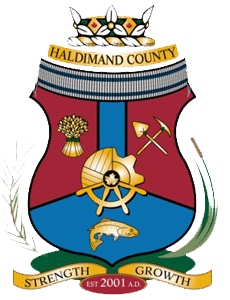Haldimand County’s Coat of Arms represents its identity and proudly reflects important elements of both historical aspects of and every day life in the County, from farming, industry and transportation to nature and recreation. Learn the meaning behind each element of the Coat of Arms.
Coat of Arms

Interpretation of Symbols
Crest
Representing all that are subject to the laws of Canada. We felt that a simplified version of the crown allowed for a cleaner and more perceptible symbol.
Trillium
The three trilliums in the crest represent the three former municipalities (Haldimand, Dunnville and Nanticoke). It is also the Ontario provincial flower and is typical flora of this area.
Wampum Belt
Represents an historical artifact used by the Six Nations Indians as a belt or sash on which hieroglyphic records were strung with polished shells. This particular belt portrays a Two-Row Wampum Belt.
The Two-Row Treaty is a formal agreement between two nations. Three rows of white beads, which symbolize peace, friendship and respect, separate the two purple rows. The two purple rows depict two paths, or two vessels traveling down the same river. One row symbolizes the Iroquoian Confederacy with its law, customs and ways and the other symbolizes the European nations. Both paths or vessels move side by side in the same direction, neither interfering with the other.
Shield
An indispensable element of a coat of arms, representing unity and working together in harmony. The shield is a strong, central element on which the symbols of identification are fixed. The design borrows from the 1850 version of the old Haldimand County coat of arms.
The shield also reflects our three-in-one theme with its three sections of the shield.
Colours
The dominant colours, gold, burgundy, blue and green symbolize the riches of the land, the waters that replenish it and the people who call this area home. The same colours are also used in the Haldimand County logo.
Water
The very centre of the shield represents the Grand River and its destination, Lake Erie. The central position on the shield indicates the vital importance of both river and lake to farming, industry and recreation throughout Haldimand’s history.
Sheaves
Represent the rich farmlands and bountiful agricultural produce (grain, fruit, vegetables, livestock) extending far into Haldimand’s past.
Mill Stone
Represents the use of the Grand River to power the flour and grist mills which sustained early settlements.
Pick and Shovel
Represent gypsum mining, probably the first modern organized industry in the Haldimand area.
Cog
Represents industries and labour of the people of the past and present, evoking the industrial development which has provided many people of Haldimand with employment.
Fish
Represents the popularity of sports fishing which has made the Grand River one of the best known destinations in North America. It also symbolizes the commercial fishing industry which has flourished along Haldimand’s waterways since the early 1800s.
Riverboat Wheel
Represents early water transportation and the Grand River Navigation Company which is a significant part of Haldimand’s history.
Bulrushes
Represent the natural life of many marshy areas found along the river’s edge and throughout Haldimand County.
Willow Branches
Represent many trees that can be found growing along the river and elsewhere in Haldimand. The branches of the willow show flexibility and strength.
Motto
Hinting at excellence and the history of the County, we felt that the motto should reflect how strength is gained through a unified people.

